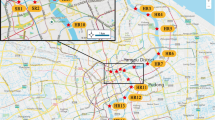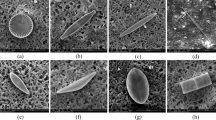Abstract
The diagnosis of drowning is one of the most difficult tasks in forensic medicine. The diatom test is a complementary analysis method that may help the forensic pathologist in the diagnosis of drowning and the localization of the drowning site. This test consists in detecting or identifying diatoms, unicellular algae, in tissue and water samples. In order to observe diatoms under light microscopy, those samples may be digested by enzymes such as proteinase K. However, this digestion method may leave high amounts of debris, leading thus to a difficult detection and identification of diatoms. To the best of our knowledge, no model is proved to detect and identify accurately diatom species observed in highly complex backgrounds under light microscopy. Therefore, a novel method of model development for diatom detection and identification in a forensic context, based on sequential transfer learning of object detection models, is proposed in this article. The best resulting models are able to detect and identify up to 50 species of forensically relevant diatoms with an average precision and an average recall ranging from 0.7 to 1 depending on the concerned species. The models were developed by sequential transfer learning and globally outperformed those developed by traditional transfer learning. The best model of diatom species identification is expected to be used in routine at the Medicolegal Institute of Paris.


Similar content being viewed by others
References
Piette MHA, De Letter EA (2006) Drowning: still a difficult autopsy diagnosis. Forensic Sci Int 163:1–9. https://doi.org/10.1016/j.forsciint.2004.10.027
Pollanen MS (1998) Diatoms and homicide. Forensic Sci Int 91:29–34. https://doi.org/10.1016/S0379-0738(97)00162-X
Blanco S (2020) Diatom Taxonomy and Identification Keys. In: Cristóbal G, Blanco S, Bueno G (eds) Modern Trends in Diatom Identification. Springer International Publishing, Cham, pp 25–38
Ludes B, Quantin S, Coste M, Mangin P (1994) Application of a simple enzymatic digestion method for diatom detection in the diagnosis of drowning in putrified corpses by diatom analysis. Int J Legal Med 107:37–41. https://doi.org/10.1007/BF01247273
Rana A (2018) Significance of diatoms in diagnosis of drowning deaths: a review. Peer Rev J Forensic Genet Sci 1. https://doi.org/10.32474/PRJFGS.2018.01.000121
Ludes B, Coste M, Tracqui A, Mangin P (1996) Continuous river monitoring of the diatoms in the diagnosis of drowning. J Forensic Sci 41:13928J. https://doi.org/10.1520/JFS13928J
Zhou Y, Cao Y, Huang J, Deng K, Ma K, Zhang T, Chen L, Zhang J, Huang P (2020) Research advances in forensic diatom testing. Forensic Sci Res 5:98–105. https://doi.org/10.1080/20961790.2020.1718901
Ming M, Meng X, Wang E (2007) Evaluation of four digestive methods for extracting diatoms. Forensic Sci Int 170:29–34. https://doi.org/10.1016/j.forsciint.2006.08.022
Zhou Y, Zhang J, Huang J, Deng K, Zhang J, Qin Z, Wang Z, Zhang X, Tuo Y, Chen L, Chen Y, Huang P (2019) Digital whole-slide image analysis for automated diatom test in forensic cases of drowning using a convolutional neural network algorithm. Forensic Sci Int 302:109922. https://doi.org/10.1016/j.forsciint.2019.109922
Pedraza A, Bueno G, Deniz O, Cristóbal G, Blanco S, Borrego-Ramos M (2017) Automated Diatom Classification (Part B): a deep learning approach. Appl Sci 7:460. https://doi.org/10.3390/app7050460
Deng J, Wei H, He D, Gu G, Kang X, Liang H, Liu C, Wu P, Zhong Y, Xu S, Ling W-K, Zhao J (2022) A coarse to fine framework for recognizing and locating multiple diatoms with highly complex backgrounds in forensic investigation. Multimed Tools Appl 81:4839–4857. https://doi.org/10.1007/s11042-021-11169-4
Moons KGM, Altman DG, Reitsma JB, Ioannidis JPA, Macaskill P, Steyerberg EW, Vickers AJ, Ransohoff DF, Collins GS (2015) Transparent Reporting of a multivariable prediction model for Individual Prognosis Or Diagnosis (TRIPOD): explanation and elaboration. Ann Intern Med 162:W1–W73. https://doi.org/10.7326/M14-0698
Spaulding SA, Potapova MG, Bishop IW, Lee SS, Gasperak TS, Jovanoska E, Furey PC, Edlund MB (2021) Diatoms.org : supporting taxonomists, connecting communities. Diatom Res 36:291–304. https://doi.org/10.1080/0269249X.2021.2006790
Devi D, Biswas SK, Purkayastha B (2020) A review on solution to class imbalance problem: undersampling approaches. 2020 International Conference on Computational Performance Evaluation (ComPE). IEEE, Shillong, India, pp 626–631
Thurzo A, Kosnáčová HS, Kurilová V, Kosmeľ S, Beňuš R, Moravanský N, Kováč P, Kuracinová KM, Palkovič M, Varga I (2021) Use of advanced artificial intelligence in forensic medicine, forensic anthropology and clinical anatomy. Healthcare 9:1545. https://doi.org/10.3390/healthcare9111545
Zhao Z-Q, Zheng P, Xu S-T, Wu X (2019) Object detection with deep learning: a review. IEEE Trans Neural Netw Learn Syst 30:3212–3232. https://doi.org/10.1109/TNNLS.2018.2876865
Ribani R, Marengoni M (2019) A Survey of Transfer Learning for Convolutional Neural Networks. 2019 32nd SIBGRAPI Conference on Graphics, Patterns and Images Tutorials (SIBGRAPI-T). IEEE, Rio de Janeiro, Brazil, pp 47–57
Lin T-Y, Maire M, Belongie S, Bourdev L, Girshick R, Hays J, Perona P, Ramanan D, Zitnick CL, Dollár P (2014) Microsoft COCO: Common Objects in Context. arXiv:405.0312. https://doi.org/10.48550/ARXIV.1405.0312
Loshchilov I, Hutter F (2016) SGDR: Stochastic Gradient Descent with Warm Restarts. https://doi.org/10.48550/ARXIV.1608.03983
Goodfellow I, Bengio Y, Courville A (2016) Deep learning. The MIT Press, Cambridge, Massachusetts
Wani MA, Bhat FA, Afzal S, Khan AI (2020) Advances in Deep Learning. UK, Springer Singapore, Singapore
Padilla R, Passos WL, Dias TLB, Netto SL, da Silva EAB (2021) A comparative analysis of object detection metrics with a companion open-source toolkit. Electronics 10:279. https://doi.org/10.3390/electronics10030279
Gong M, Wang D, Zhao X, Guo H, Luo D, Song M (2021) A review of non-maximum suppression algorithms for deep learning target detection. In: Chu J, Yu Q, Jiang H, Su J (eds) Seventh Symposium on Novel Photoelectronic Detection Technology and Applications. SPIE, Kunming, China, p 133
Yu H, Chen C, Du X, Li Y, Rashwan A, Hou L, Jin P, Yang F, Liu F, Kim J, Li J (2020) Tensorflow Model Zoo. Available at: https://github.com/tensorflow/models/blob/master/research/object_detection/g3doc/tf2_detection_zoo.md. Accessed 29 Sept 2023
Yu H, Chen C, Du X, Li Y, Rashwan A, Hou L, Jin P, Yang F, Liu F, Kim J, Li J (2020) Tensorflow Model Garden. Available at: https://github.com/tensorflow/models. Accessed 29 Sept 2023
LeCun Y, Bengio Y, Hinton G (2015) Deep learning. Nature 521:436–444. https://doi.org/10.1038/nature14539
Lin T-Y, Goyal P, Girshick R, He K, Dollár P (2017) Focal Loss for Dense Object Detection. arXiv: 1708.02002. https://doi.org/10.48550/ARXIV.1708.02002
Wilcoxon F (1945) Individual comparisons by ranking methods. Biom Bull 1:80. https://doi.org/10.2307/3001968
Virtanen P, Gommers R, Oliphant TE, Haberland M, Reddy T, Cournapeau D, Burovski E, Peterson P, Weckesser W, Bright J, van der Walt SJ, Brett M, Wilson J, Millman KJ, Mayorov N, Nelson ARJ, Jones E, Kern R, Larson E, Carey CJ, Polat İ, Feng Y, Moore EW, VanderPlas J, Laxalde D, Perktold J, Cimrman R, Henriksen I, Quintero EA, Harris CR, Archibald AM, Ribeiro AH, Pedregosa F, van Mulbregt P, SciPy 1.0 Contributors, Vijaykumar A, Bardelli AP, Rothberg A, Hilboll A, Kloeckner A, Scopatz A, Lee A, Rokem A, Woods CN, Fulton C, Masson C, Häggström C, Fitzgerald C, Nicholson DA, Hagen DR, Pasechnik DV, Olivetti E, Martin E, Wieser E, Silva F, Lenders F, Wilhelm F, Young G, Price GA, Ingold G-L, Allen GE, Lee GR, Audren H, Probst I, Dietrich JP, Silterra J, Webber JT, Slavič J, Nothman J, Buchner J, Kulick J, Schönberger JL, de Miranda Cardoso JV, Reimer J, Harrington J, Rodríguez JLC, Nunez-Iglesias J, Kuczynski J, Tritz K, Thoma M, Newville M, Kümmerer M, Bolingbroke M, Tartre M, Pak M, Smith NJ, Nowaczyk N, Shebanov N, Pavlyk O, Brodtkorb PA, Lee P, McGibbon RT, Feldbauer R, Lewis S, Tygier S, Sievert S, Vigna S, Peterson S, More S, Pudlik T, Oshima T, Pingel TJ, Robitaille TP, Spura T, Jones TR, Cera T, Leslie T, Zito T, Krauss T, Upadhyay U, Halchenko YO, Vázquez-Baeza Y (2020) SciPy 1.0: fundamental algorithms for scientific computing in Python. Nat Methods 17:261–272. https://doi.org/10.1038/s41592-019-0686-2
Acknowledgements
The authors warmly thank Pr. Jean-Sébastien Raul and Evelyne Jehl (Medicolegal Institute of Strasbourg, Strasbourg, France) for the preparation and the provision of diatom slides from real suspected drowning cases.
Author information
Authors and Affiliations
Contributions
Conceptualization and methodology of this work were designed by Laurent Tournois, Didier Hatsch, and Bertrand Ludes. Supervision, project administration, and resources were handled by Didier Hatsch and Bertrand Ludes. Data curation, formal analysis, investigation, software, validation, and visualization were performed by Laurent Tournois. The first draft of the manuscript was written by Laurent Tournois, and all authors commented on previous versions of the manuscript. All authors read and approved the final manuscript.
Corresponding author
Ethics declarations
Ethics approval
Not applicable.
Research involving human participants and/or animals
Not applicable.
Informed consent
Not applicable.
Conflict of interest
The authors declare no competing interests.
Additional information
Publisher's Note
Springer Nature remains neutral with regard to jurisdictional claims in published maps and institutional affiliations.
Rights and permissions
Springer Nature or its licensor (e.g. a society or other partner) holds exclusive rights to this article under a publishing agreement with the author(s) or other rightsholder(s); author self-archiving of the accepted manuscript version of this article is solely governed by the terms of such publishing agreement and applicable law.
About this article
Cite this article
Tournois, L., Hatsch, D., Ludes, B. et al. Automatic detection and identification of diatoms in complex background for suspected drowning cases through object detection models. Int J Legal Med 138, 659–670 (2024). https://doi.org/10.1007/s00414-023-03096-w
Received:
Accepted:
Published:
Issue Date:
DOI: https://doi.org/10.1007/s00414-023-03096-w




